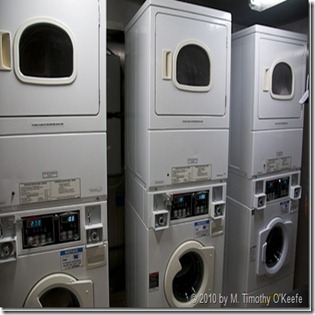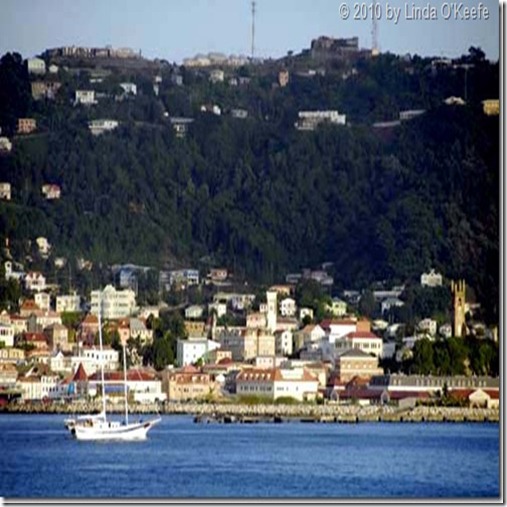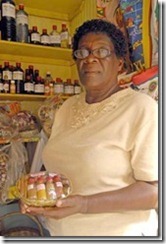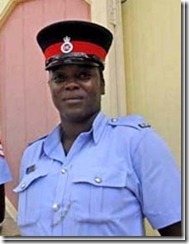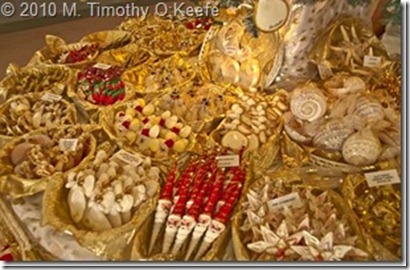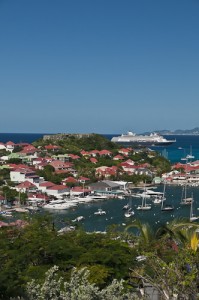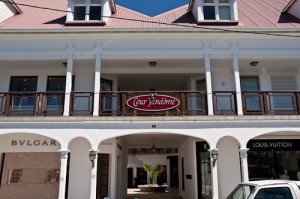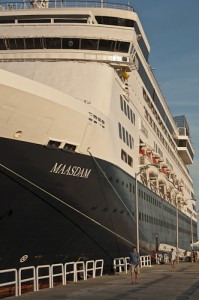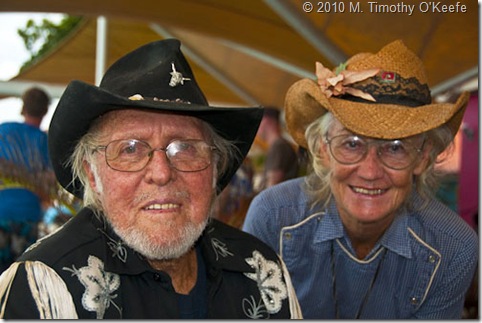
Don and Janet at Habitat, on our cruise lunch stop on Bonaire.
Captain Don Stewart, Bonaire Dive Pioneer
For days a number of people on the Maasdam have talked of nothing but Bonaire and theie chance to snorkel or dive the island’s famous close-to-shore reefs. Linda and I won’t get wet with the others. Instead, we are having lunch with Captain Don Stewart, the dive pioneer who made Bonaire’s underwater world internationally famous.
More than that, he took the first concerted steps anywhere in the Caribbean to protect the island’s fragile reef system, which has become the basis for most Bonaire tourism. While dive operators throughout the Caribbean and even the Florida Keys in the 1970s were still throwing out anchors on each dive, crushing great clumps of coral each time they did, Don spearheaded a campaign to have permanent dive moorings placed at each dive site. That way the boats only needed to tie up to the moorings to unload their divers.
We are meeting Don at Habitat, the dive resort he founded in the 1970s and in which he still remains a minority shareholder. As it turns out, this is a good day to be on dry land with Don. For the first time since I’ve come to Bonaire in 1975, the island is experiencing a thunderstorm, a real frog strangler.
Shortly before noon, right on schedule, Don Stewart and Janet, his fiancée and sidekick for 28 years, enter the open air Rum Runner restaurant. I have been trying to figure out a special way to greet the 85-year old Bonaire legend. Since I last saw him he has become an honest-to-god Knight of the Netherlands. But I immediately forget about his “Sir-ness.”
This is the first time I’ve seen him since he had his lower right leg amputated several years ago. Don, rather than wear prosthesis, opted for an artificial leg with much more flair. Always fond of pirates and dressing like one, Don now has a peg leg. And the massive black crutch he leans on is a perfect replica of one used by Long John Silver in the various Treasure Island movies.
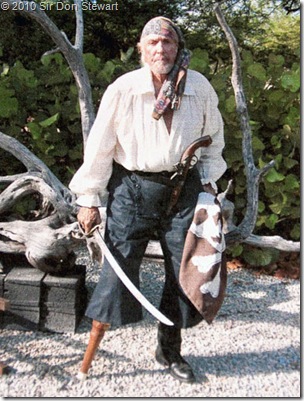
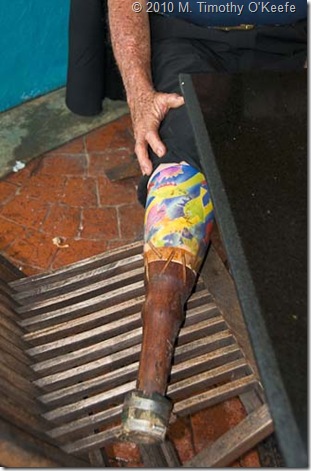
Capt’n Don lives out his pirate fantasy in ways he never imagined
Instead of being dressed as a pirate, Don is wearing a black shirt with white fringe I gave him between 20 and 25 years ago when he and Janet appeared at Habitat as cowboy and cowgirl for their weekly slide presentation on Bonaire’s dive history. The shirt doesn’t quite fit anymore; too hard to button thanks to all the “muscle” he’s grown from using his crutch.
“I hope you are impressed that I am wearing this thing,” he says with his trademark, abrupt greeting as he touches the fringe. “Can I take it off now? It’s too hot to be wearing it.” I’m honored he still has the garment.
He raises his leg and puts his foot—uh, peg foot?—in the chair beside me to examine. “You know how much that always hurt, for 25 long years after the accident. It was a lucky day when I met that doctor who owned an axe and told me “I’ll take that pain away for you, Capt’n Don.’”
So what did you do with the leg, I ask him. Bury it?
“As soon as they removed my leg, they wrapped it up and took it out to Janet. Now it’s buried in the small pyramid with two doors, one for me, one for Janet. You could say I have a foot in the grave, already,” he jokes.
Don Stewart, always with the jokes, always just a little outrageous. It’s why some people have a hard time taking his ideas seriously. And why one noted writer called him “macho, arrogant and bumptious,” which he declared was a great compliment.
Always surly, he is now an official “Sir”
But not just anyone is knighted, as Don was just a few years ago. Formally, his title is Knight (Dutch: Ridder) within the Order of Orange-Nassau, founded in 1892 on behalf of Queen Wilhelmina of Netherlands. This is considered the most active military and civil decoration of the Netherlands, according to Janet, who can be relied on for factual information.
This is the highest of his many awards, which include the DEMA Reaching Out Award, the highest award in the dive industry; he also was inducted into the Diving Hall of Fame, which includes Jacques Cousteau, inventor of the aqua-lung; Hans Haas, an underwater explorer years before the more famous Cousteau; and Lloyd Bridges, who portrayed Mike Nelson on TV’s “Sea Hunt,” the first series about diving.
So significant has Don Stewart’s impact been on Bonaire that in May of 1992 the island celebrated his 30th anniversary on Bonaire with a reenactment of his arrival. When Capt. Don stepped ashore–accompanied by many old dive buddies–he was met by about 500 applauding Bonaireans and the Lt. Governor, Bonaire’s highest ranking official, who officially recognized Capt’n Don’s contributions to Bonaire.
Don laughs deeply. “I wonder if the Lt. Governor knew when he made that speech that when I anchored here in 1962 that I was nothing but a boat bum who possessed only 63 cents and a 70-foot topsail schooner.”
Bonaire and Don found each other when he was 36. He’d joined the Navy at 17 during World War II, then afterwards patented a method that made it possible to fit screens into sliding glass doors, floated the Mississippi on a raft, and tried to become a Hollywood actor but claims “Lloyd Bridges upstaged me!”
Realizing he was never going to be another Errol Flynn (an actor he resembled closely) and “bored silly by instant success,” Capt. Don sold his very successful screening company, set sail for the Caribbean and floated around for almost 2 years before stumbling upon Bonaire.
Only a few thousand people and a lot of goats and cactus lived on Bonaire then. However, it didn’t take Capt. Don long to realize that this desert island surrounded by an oasis of magnificent, reefs located an easy swim from shore offered plenty of diving potential.
Very quickly, Capt. Don and Bonaire diving became synonymous. Anyone who looks through the dive publications of the 70s will recognize the stories are not really about Bonaire.
Instead, they focus on Capt. Don and what he says about Bonaire’s diving: “Some of the best in the world,” he claimed.
This former screen salesman and budding actor said it so convincingly and so colorfully that no one doubted him. However, Capt. Don has always made it plain that he never guarantees more than 85% truth; having people pick out the 15% that’s hogwash is game he’s always loved to play. “I knew the diving was good here but I never really thought it the best in the world,” he has admitted in recent years. “It’s just that everyone believed me.”
With Bonaire a diving mecca, Capt. Don decided to build a special resort designed just for divers, so he invested everything he had to open his own resort in 1976. Called Capt. Don’s Habitat, it was one of the Caribbean’s first resorts built by and especially for divers.
It was at Capt. Don’s Habitat that the concept of “Dive Freedom,” where divers could dive anytime they wished, literally 24-hours a day, was initiated. It was another Caribbean first.
Yet Capt. Don was always more than a hotelier. Long before Habitat he began preaching what he calls his “man/sea concept” which holds that “It is our right to realize an unrestricted use of our world seas, for pleasure, for knowledge, and economic advance, while ensuring that our human trespass shall leave no mark.”
A one-man Greenpeace, Capt. Don carried out his words with some considerable deeds. He had spearfishing banned on Bonaire in the 1970s as well as eliminating the need for reef-destroying anchors with the first mooring buoy system in the Caribbean, perhaps in the world.
When Bonaire decided to designate its reefs a national Marine Park, they were still pristine. Because the good Capt’n and many of the island’s other dive operators (whom Don had trained) along with the visiting divers who believed in his philosophy made it so. Yet the first guide to the Marine Park never hinted at any of Don’s contributions. He was not a trained scientist and moreover he was an outsider, he wasn’t Bonairean or Dutch.
It sometimes has been amazing how little known Capt’n Don’s contributions have been recognized on Bonaire or by its people. Some always will view him as a comic character who wore pirate garb or cowboy duds to Habitat parties, drank too much (he stopped drinking 16 years ago) and told lots of bawdy tales.
Some on Bonaire were jealous of this 5th grade drop-out who’s gained so much international attention when they have not; of course, they never had Capt. Don’s acting background to create their own flamboyant persona.
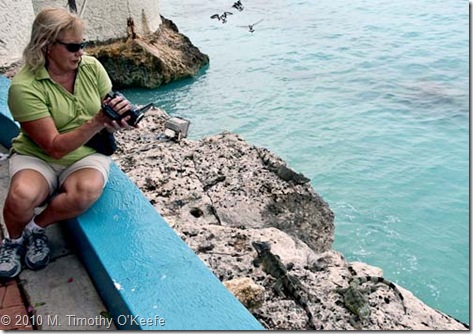
Linda videos green iguanas (lower right) basking on coral ledge
beside Habitat’s Rum Runner’s Restaurant
Capt. Don’s days of serious diving, however, ended in 1980 when he injured his foot and ankle in a salvage accident. He remained at Habitat until 1987, when he sold the resort and became a minority shareholder.
The hotel still uses his name and his famous symbol of the skull and cutlass to form the diver’s flag that he originated almost 5 decades ago. (Capt. Don has no affiliation with Curacao’s Habitat, which does promote many of his concepts though not his name.)
Capt. Don appears at Habitat once a week to narrative a slide show on Bonaire’s early days of diving. For information, http://www.habitatbonaire.com/.
Today, Capt. Don lives in a modest home at his plant farm, Island Grower. He shares his kunuku (farm) with Janet Thibault, his lady and sidekick since 1982. His house has no electricity. In Bonaire’s hot sunny climate bathed by the trade winds, Don uses solar and wind power to charge his stockpile of batteries.
If the home is unpretentious, the plagues, trophies and other wall hangings there are amazing. Among the many environmental awards is a framed 1977 Sunday front page comic strip from the New York Daily News in which Dondi is learning scuba from “Captain Don” on the island of “Bonairy.”
The comic strip panels impart a very strong marine conservation message, something that made Capt. Don particularly pleased because of the comic strip’s 4 million readers.
Janet interjects, “Remember how you broke his Dondi frame? We never have been able to get it fixed.” That was a bad day, when we took the frame outside so I could photograph it in the sunlight. A sudden gust of wind flattened it against the gravely ground. Janet smiles. “Not really your fault. It was the wind.” I know I will never hear the end of that day, even though it happened last century.
Still bursting with energy, Don continues to push ahead on new projects. He already has helped make cyclists aware of Bonaire’s ideal landscape: flat at one end, hilly at the other. Now he is looked for a new group to attract. “Maybe it should be alcoholics,” he says, noting his own problem in that area. “We could have them come here to dry out. Or maybe just drink as much as they want. Still don’t have a handle on that.”
On a more serious level, he is advocating a conservation-based comic book for the island’s school children so they will learn from an early age the importance of Bonaire’s reefs to their futures.
Best of all, Don finally is doing what his fans have wanted for years: publishing his exploits. Don always has been an avid writer, but his style is as unconventional as is his life. Although he tried for years to interest someone, no agent or publisher would touch his material. So, like Benjamin Franklin and Arthur Frommer (at first), he is self-publishing. See his titles at http://captaindonbooks.com.
His novel Sea Trauma—the name reveals the book’s strong conservation theme—is one he has worked on and promoted since I’ve known him. The parts of Sea Trauma I read long ago convinced me it had real potential.
Sir Don growls at me, “Still can’t believe you got someone to publish a book called 99 Uses For A Dead Cockroach. Disgusting! Who wants to read about cockroaches?” I remind him how rare a book that title is, and how lucky he is to have it in his collection.
Our three-hour lunch passes much too quickly. When it’s time to leave, he waves and hobbles to his jeep in the rain. “We don’t say good-bye” he calls over his shoulder. I remember the custom. With no good-byes said, it means you’re welcome back.
I wouldn’t know how to say good-by to Don, anyway. After all this time, it’s still hard for me to pinpoint all his achievements and my affection for him. Perhaps the underwater plaque placed at Don’s Reef, a dive site on Klein Bonaire dedicated to Capt. Don on his 30th anniversary, best summarizes how many of us feel about Capt’n/Sir. Don Stewart: “From all of the marine life his efforts have helped to save, and from all who have enjoyed the wonders of the sea…thank you.”
In this instance, a “thank you,” no matter how sincere, doesn’t seem sufficient.
RIP: Captain Don Stewart, the man who seemed larger than life, died at the age of 88 on May 3, 2014. Stewart, who always liked to tell a good story, claims he receive a medical discharge in World War II because he was diagnosed with terminal lymphatic cancer. Captain Don is buried in the same plot where he interred his amputated leg shortly after the surgery removing it. That’s Don, who tried never to do things the way most people do. Those who knew and loved him should find this video a fine tribute.

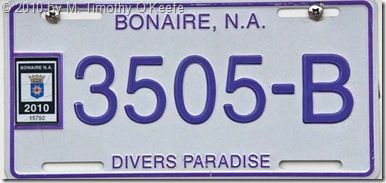
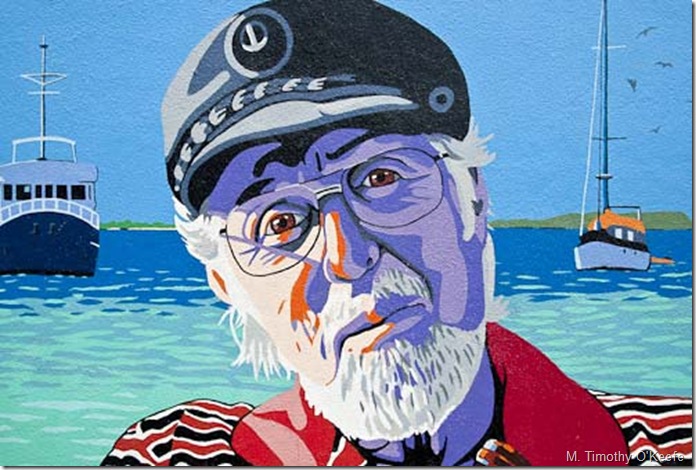
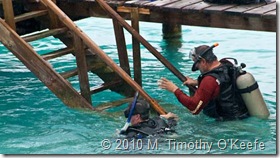

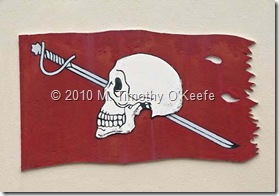
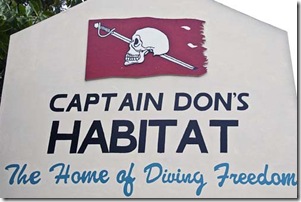
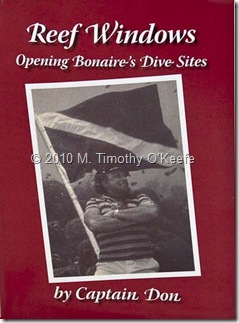
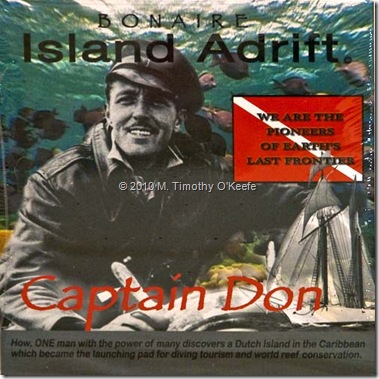
 Follow
Follow